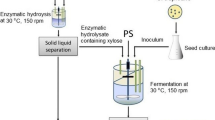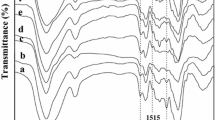Abstract
Corncob is an abundant agricultural residue containing high content of hemicellulose. In this paper, the hemicellulosic hydrolysate was prepared from the hydrolysis of corncob using the solid acid sulfated zirconia as a catalyst. According to response surface analysis experiments, the optimum conditions for preparing hemicellulosic hydrolysate catalyzed by sulfated zirconia were determined as follows: solid (sulfated zirconia)–solid (corncob) ratio was 0.33, solid (corncob)–liquid (water) ratio was 0.09, temperature was 153 °C, and time was 5.3 h. Under the optimized conditions, the soluble sugar concentration was 30.12 g/L with a yield of 033 g/g corncob. Subsequently, xylitol production from the resulting hemicellulosic hydrolysate was demonstrated by Candida tropicalis, and results showed that the yield of xylitol from the hemicellulosic hydrolysate could be significantly improved on a basis of decolorization and detoxification before fermentation. The maximum yield of xylitol from the hemicellulosic hydrolysate fermented by C. tropicalis was 0.76 g/g. This study provides a new attempt for xylitol production from the hemicellulosic hydrolysate.




Similar content being viewed by others
Data Availability
All data are fully available without restriction.
References
Rao, R. S., Jyothi, C. P., Prakasham, R. S., Sarma, P. N., & Rao, L. V. (2006). Xylitol production from corn fiber and sugarcane bagasse hydrolysates by Candida tropicalis. Bioresource Technology, 97(15), 1974–1978.
Yu, J., Li, Z., Ye, Q., Yang, Y., & Chen, S. (2010). Development of succinic acid production from corncob hydrolysate by Actinobacillus succinogenes. Journal of Industrial Microbiology & Biotechnology, 37(10), 1033–1040.
Cheng, K. K., Zhang, J. A., Chavez, E., & Li, J. P. (2010). Integrated production of xylitol and ethanol using corncob. Applied Microbiology and Biotechnology, 87(2), 411–417.
Xu, Y., & Hanna, M. A. (2010). Optimum conditions for dilute acid hydrolysis of hemicellulose in dried distillers grains with solubles. Industrial Crops and Products, 32(3), 511–517.
Yang, B., & Wyman, C. E. (2008). Pretreatment: the key to unlocking low-cost cellulosic ethanol. Biofuels, Bioproducts and Biorefining, 2(1), 26–40.
Ormsby, R., Kastner, J. R., & Miller, J. (2012). Hemicellulose hydrolysis using solid acid catalysts generated from biochar. Catalysis Today, 190(1), 89–97.
Zhong, C., Wang, C., Huang, F., Wang, F., Jia, H., Zhou, H., & Wei, P. (2015). Selective hydrolysis of hemicellulose from wheat straw by a nanoscale solid acid catalyst. Carbohydrate Polymers, 131, 384–391.
Weyda, I., Lübeck, M., Ahring, B. K., & Lübeck, P. S. (2014). Point mutation of the xylose reductase (XR) gene reduces xylitol accumulation and increases citric acid production in Aspergillus carbonarius. Journal of Industrial Microbiology & Biotechnology, 41(4), 733–739.
Rao, L. V., Goli, J. K., Gentela, J., & Koti, S. (2016). Bioconversion of lignocellulosic biomass to xylitol: An overview. Bioresource Technology, 213, 299–310.
Camargo, D., Sene, L., Variz, D. I. L. S., & Felipe, M. G. A. (2015). Xylitol bioproduction in hemicellulosic hydrolysate obtained from sorghum forage biomass. Applied Biochemistry and Biotechnology, 175(8), 3628–3642.
López-Linares, J. C., Romero, I., Cara, C., Castro, E., & Mussatto, S. I. (2018). Xylitol production by Debaryomyces hansenii and Candida guilliermondii from rapeseed straw hemicellulosic hydrolysate. Bioresource Technology, 247, 736–743.
Rodrigues, R. C. L. B., Kenealy, W. R., & Jeffries, T. W. (2011). Xylitol production from DEO hydrolysate of corn stover by Pichia stipitis YS-30. Journal of Industrial Microbiology & Biotechnology, 38(10), 1649–1655.
Kim, T. B., & Oh, D. K. (2003). Xylitol production by Candida tropicalis in a chemically defined medium. Biotechnology Letters, 25(24), 2085–2088.
Jeon, Y. J., Shin, H. S., & Rogers, P. L. (2011). Xylitol production from a mutant strain of Candida tropicalis. Letters in Applied Microbiology, 53(1), 106–113.
Jia, H., Shao, T., Zhong, C., Li, H., Jiang, M., Zhou, H., & Wei, P. (2016). Evaluation of xylitol production using corncob hemicellulosic hydrolysate by combining tetrabutylammonium hydroxide extraction with dilute acid hydrolysis. Carbohydrate Polymers, 151, 676–683.
Meinita, M. D. N., Hong, Y. K., & Jeong, G. K. (2012). Detoxification of acidic catalyzed hydrolysate of Kappaphycus alvarezii (cottonii). Bioprocess and Biosystems Engineering, 35(1–2), 93–98.
Alriksson, B., Cavka, A., & Jönsson, L. J. (2011). Improving the fermentability of enzymatic hydrolysates of lignocellulose through chemical in-situ detoxification with reducing agents. Bioresource Technology, 102(2), 1254–1263.
Chen, Y., Dong, B., Qin, W., & Xiao, D. (2010). Xylose and cellulose fractionation from corncob with three different strategies and separate fermentation of them to bioethanol. Bioresource Technology, 101(18), 6994–6999.
Zhang, J. K., Gao, R., Dou, D. Q., & Kang, T. G. (2013). The ginsenosides and carbohydrate profiles of ginseng cultivated under mountainous forest. Pharmacognosy Magazine, 9(Suppl 1), S38–S43.
Said, A. E. A. A., El-Wahab, M. M. A., & El-Aal, M. A. (2014). The catalytic performance of sulfated zirconia in the dehydration of methanol to dimethyl ether. Journal of Molecular Catalysis A: Chemical, 394, 40–47.
Liao, Y., Huang, X., Liao, X., & Shi, B. (2011). Preparation of fibrous sulfated zirconia (SO42−/ZrO2) solid acid catalyst using collagen fiber as the template and its application in esterification. Journal of Molecular Catalysis A: Chemical, 347(1-2), 46–51.
Zalewski, D. J., Alerasool, S., & Doolin, P. K. (1999). Characterization of catalytically active sulfated zirconia. Catalysis Today, 53(3), 419–432.
Mekhemer, G. A. H. (2006). Surface characterization of zirconia, holmium oxide/zirconia and sulfated zirconia catalysts. Colloids and Surfaces A: Physicochemical and Engineering Aspects, 274(1-3), 211–218.
Sun, Y. Y., Ma, S. Q., Du, Y. C., Yuan, L., Wang, S. C., Yang, J., Deng, F., & Xiao, F. S. (2005). Solvent-free preparation of nanosized sulfated zirconia with Brønsted acidic sites from a simple calcination. The Journal of Physical Chemistry B, 109(7), 2567–2572.
Yan, H. P., Yang, Y., Tong, D. M., Xiang, X., & Hu, C. W. (2009). Catalytic conversion of glucose to 5-hydroxymethylfurfural over SO42−/ZrO2 and SO42−/ZrO2-Al2O3 solid acid catalysts. Catalysis Communications, 10(11), 1558–1563.
Gupta, P., & Paul, S. (2014). Solid acids: green alternatives for acid catalysis. Catalysis Today, 236, 153–170.
Chen, N., Zhang, G., Zhang, P., Tao, X., Wu, Y., Wang, S., & Nabi, M. (2019). Rice husk-based solid acid for efficient hydrolysis and saccharification of corncob. Bioresource Technology, 292, 121915.
Qi, W., He, C., Wang, Q., Liu, S., Yu, Q., Wang, W., Leksawasdi, N., Wang, C. G., & Yuan, Z. H. (2018). Carbon-based solid acid pretreatment in corncob saccharification: specific xylose production and efficient enzymatic hydrolysis. ACS Sustainable Chemistry & Engineering, 6(3), 3640–3648.
Dominguez, J. M., Cao, N., Gong, C. S., & Tsao, G. T. (1997). Dilute acid hemicellulose hydrolysates from corn cobs for xylitol production by yeast. Bioresource Technology, 61(1), 85–90.
Shah, S. S. M., Luthfi, A. A. I., Low, K. O., Harun, S., Manaf, S. F. A., Illias, R. M., & Jahim, J. M. (2019). Preparation of kenaf stem hemicellulosic hydrolysate and its fermentability in microbial production of xylitol by Escherichia coli BL21. Scientific Reports, 9(1), 4080.
Jönsson, L. J., Alriksson, B., & Nilvebrant, N. O. (2013). Bioconversion of lignocellulose: inhibitors and detoxification. Biotechnology for Biofuels, 6(1), 16.
Huang, C. F., Jiang, Y. F., Guo, G. L., & Hwang, W. S. (2011). Development of a yeast strain for xylitol production without hydrolysate detoxification as part of the integration of co-product generation within the lignocellulosic ethanol process. Bioresource Technology, 102(3), 3322–3329.
Kumar, V., Sandhu, P. P., Ahluwalia, V., Mishra, B. B., & Yadav, S. K. (2019). Improved upstream processing for detoxification and recovery of xylitol produced from corncob. Bioresource Technology, 291, 121931.
De Carvalho, W., Canilha, L., Mussatto, S. I., Dragone, G., Morales, M. L., & Solenzal, A. I. N. (2004). Detoxification of sugarcane bagasse hemicellulosic hydrolysate with ion-exchange resins for xylitol production by calcium alginate-entrapped cells. Journal of Chemical Technology & Biotechnology, 79(8), 863–868.
Alves, L. A., Felipe, M. G. A., Silva, J. B. A. E., Silvio, S. S., & Prata, A. M. R. (1998). Pretreatment of sugarcane bagasse hemicellulose hydrolysate for xylitol production by Candida guilliermondii. Applied Biochemistry and Biotechnology, 72, 89–97.
Kamal, S. M. M., Mohamad, N. L., Abdullah, A. G. L., & Abdullah, N. (2011). Detoxification of sago trunk hydrolysate using activated charcoal for xylitol production. Procedia Food Science, 1, 908–913.
Cao, N. J., Tang, R., Gong, C. S., & Chen, L. F. (1994). The effect of cell density on the production of xylitol from D-xylose by yeast. Applied Biochemistry and Biotechnology, 45–46(1), 515–519.
Sampaio, F. C., de Moraes, C. A., De Faveri, D., Perego, P., Converti, A., & Passos, F. M. L. (2006). Influence of temperature and pH on xylitol production from xylose by Debaryomyces hansenii UFV-170. Process Biochemistry, 41(3), 675–681.
Hahn-Hägerdal, B., Karhumaa, K., Fonseca, C., Spencer-Martins, I., & Gorwa-Grauslund, M. F. (2007). Towards industrial pentose-fermenting yeast strains. Applied Microbiology and Biotechnology, 74(5), 937–953.
Morais Junior, W. G., Pacheco, T. F., Trichez, D., Almeida, J. R. M., & Gonçalves, S. B. (2019). Xylitol production on sugarcane biomass hydrolysate by newly identified Candida tropicalis JA2 strain. Yeast., 36(5), 349–361.
Jiang, X., He, P., Qi, X., Lin, Y., Zhang, Y., & Wang, Q. (2016). High-efficient xylitol production by evolved Candida maltosa adapted to corncob hemicellulosic hydrolysate. Journal of Chemical Technology & Biotechnology, 91(12), 2994–2999.
Funding
The authors received financial support from NSFC (21676142), the National Key Research and Development Program of China (2018YFA0902200), Jiangsu Agricultural Science and Technology Innovation Fund Project (CX(19)2001), Qing Lan Project of Jiangsu Universities, Six Talent Peaks Project in Jiangsu Province, and the Jiangsu Synergetic Innovation Center for Advanced Bio-Manufacture.
Author information
Authors and Affiliations
Corresponding author
Ethics declarations
Competing interests
The authors declare that they have no competing interests.
Ethics Approval and Consent to Participate
This article does not contain any studies with human participants or animals performed by any of the authors.
Consent for Publication
This study does not contain any individual person’s data.
Additional information
Publisher’s Note
Springer Nature remains neutral with regard to jurisdictional claims in published maps and institutional affiliations.
Electronic supplementary material
ESM 1
(DOCX 334 kb)
Rights and permissions
About this article
Cite this article
Wan, L., Gao, Z., Wu, B. et al. Hydrolysis of Corncob Hemicellulose by Solid Acid Sulfated Zirconia and Its Evaluation in Xylitol Production. Appl Biochem Biotechnol 193, 205–217 (2021). https://doi.org/10.1007/s12010-020-03412-9
Received:
Accepted:
Published:
Issue Date:
DOI: https://doi.org/10.1007/s12010-020-03412-9




